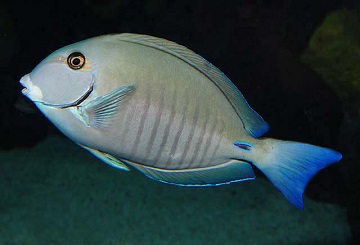450917-doctorfish.jpg

Doctorfish have sharp spines called scalpels on the sides of their bodies. Credit: D. Ross Robertson, Smithsonian Institution
The doctorfish sounds like it should scurry from reef to reef, healing other fish along the way. In reality, though, the name tells us that the fish is dangerous: It can inflict nasty cuts on rivals and predators using two “scalpels” on its sides.
The doctorfish grows up to about 15 inches long, and can weigh up to about 10 pounds. It has a tall, flat body that’s blue-gray or brown, with vertical stripes on its sides.
It lives in warm, shallow waters near the coastline, around coral reefs and along rocky sea beds. It’s found along the Atlantic and Gulf coasts of the United States, through the Caribbean, and down the coast of South America to Brazil. It also may be found along the Atlantic coast of Africa. It eats algae off the coral, and off the rocks and sand on the sea floor. And juvenile doctorfish sometimes group together to eat parasites and dead skin off green turtles.
The doctorfish is one species of a large group of fish known as surgeonfish. And that provides a clue to the name. Like other surgeonfish, the doctorfish has spines on the sides of its body, just in front of its tail. Those spines are called scalpels, and they’re quite sharp, so they inflict some nasty cuts.
The fish uses the scalpels mainly to ward off predators, and to protect its territory from other doctorfish. It can rapidly thrash its tail from side to side, making the scalpels effective weapons. So other creatures that encounter the doctorfish may need the help of a doctor after it’s over.

